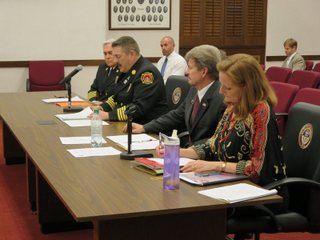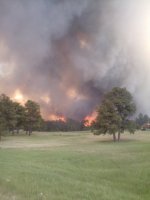Bipartisan Aerial Firefighting Effort Heard in Committee
- Mountain-News-Events
-
 Topic Author
Topic Author
- Mountain Legend
-

Bipartisan Aerial Firefighting Effort Heard in Committee
DENVER, April 10, 2014 – The Senate Agriculture, Natural Resources, and Energy Committee discussed legislation today to bolster state firefighting resources in the wake of horrific fires within the past few years. Coloradans suffered through the historic High Park and Waldo Canyon fires in 2012, and the next year, suffered through the Black Forest Fire. Those three fires alone scorched nearly 120,000 acres, destroyed over 1,100 homes, and killed five people.
To help prevent other catastrophic wildfires, Senate Pres. Morgan Carroll, D-Aurora, worked with Sen. Steve King, R-Grand Junction, to allow the state to acquire an aerial firefighting fleet (SB 14-164).
“We must do everything possible to protect what we hold dear -- the environment, water, and the safety and wellbeing of Colorado families. The Colorado aerial firefighting fleet is an investment that will help the state spot, fight, and contain wildfires before they cause widespread damage. It is one effort of several to address overall forest health and safety,” said Pres. Carroll.
The aerial fleet is a proactive investment, as opposed to a reactive expense. According to the Colo. Division of Fire Prevention and Control for the 2012 wildfire season damage estimates currently total $567.4 million from insurance claims.
SB 14-164 builds on legislation authored last year by Sen. King and Sen. Cheri Jahn, D-Wheat Ridge. SB 13-245 established the Colorado Firefighting Air Corps by name and required the Division of Fire Prevention and Control to produce a report on aerial firefighting strategy.
SB 14-164 implements the recommendations outlined in that report, which is titled: Special Report: Colorado Firefighting Air Corps (March 2014).
The recommendations include:
• Procure a statewide license and provide training on a wildfire information management system
• Procure two multi-mission planes and that will operate in 2014
• Obtain a contact for four helicopters
• Obtain a contract for four single-engine air tankers
“I am pleased with the ongoing bipartisan effort to ensure Colorado has all the tools necessary to fight devastating wildfires. We need to do everything possible to protect Colorado and Colorado families,” said Sen. Jahn. The Senate Agriculture, Natural Resources, and Energy Committee will vote on SB 14-164 on Monday, April 14.
Photo: Chief Ken Watkins, Grand Junction Fire and Dep. Chief Norris Croom of Castle Rock Fire testify on SB 14-164 before the Senate Agriculture, Natural Resources, and Energy Committee on behalf of the Colorado State Fire Chiefs.
http://www.coloradosenate.org/

https://www.facebook.com/ColoFireChiefs ... =1&theater
My Mountain Town Community Calendar - filter events by Category, date, or keyword to easily find events of interest. Add your community, church, or non-profit event to the calendar yourself! Click here to access the submission form. Businesses: please contact us for more information on adding your events! Questions? Email
Community News, Events, and Calendar Forum - Check here for the latest happenings in our community and add your own!
Please Log in or Create an account to join the conversation.
- Engineer2207
-

- Mountain Folk
-

- Posts: 81
- Thank you received: 0
Please Log in or Create an account to join the conversation.
- ScienceChic
-

- Mountain Champion
-

- Posts: 15745
- Thank you received: 320
Is the fleet going to be solely used for Colorado?
I'm not making the decisions, but the intention is to provide a fleet for Colorado, not for the rest of the country. Several states (California, Oregon and Washington) own or lease their own firefighting aircraft. At times you might see an air tanker from California in Southern Oregon, but you're not going to see one in Colorado. California pays for their aircraft, to protect their residents and natural resources. That is what this bill is intended to do; protect Colorado assets. As such, I doubt highly that these aircraft would be listed as resources outside of Colorado. That can be seen in the description. "Exclusive Use" means they pay to have the aircraft sitting in Colorado in case of a fire; the contractor is not allowed to move the aircraft to another state without Colorado's permission.
What is included in the 21 million?
The number is still fluid. Two weeks ago, the request was $33 million. As of Friday, the number being tossed around was $19 million; not because the legislative committees were trying to dictate the kind and type of resources, but because that was the limit of funding they estimated they could pull for this project. Here is what the original report to Governor Hickenlooper included:
Multi-Mission Fixed Wing Aircraft
Purchase two Multi-Mission Fixed Wing Aircraft equipped with high tech fire detection and communications systems . . . $10 million
Operate two Multi-Mission Fixed Wing Aircraft equipped with high tech fire detection and communications systems . . . $1.7 million
Multi-Mission Rotor-Wing Aircraft
Contract for four Type III or larger rotor wing aircraft . . . $4.7 million
Single Engine Air Tankers (SEATs)
Contract for four exclusive use SEATs . . . $3.1 million
Large Fixed-Wing Air Tankers
Contract for two exclusive use large air tankers . . . $11.9 million*
Other Direct and Indirect Expenses
Additional insurance, airport fees, hanger leases, tanker base costs, personnel, supplies and equipment, etc. . . . $2.1 million
The final kinds and types of aircraft will be decided when and if the Bill passes, and the funding level is determined.
Let me know if you have any other questions.
"Now, more than ever, the illusions of division threaten our very existence. We all know the truth: more connects us than separates us. But in times of crisis the wise build bridges, while the foolish build barriers. We must find a way to look after one another as if we were one single tribe.” -King T'Challa, Black Panther
The truth is incontrovertible. Malice may attack it. ignorance may deride it, but in the end, there it is. ~Winston Churchill
Please Log in or Create an account to join the conversation.
- FredHayek
-

- Mountain Legend
-

- Posts: 30126
- Thank you received: 178
Thomas Sowell: There are no solutions, just trade-offs.
Please Log in or Create an account to join the conversation.
- Engineer2207
-

- Mountain Folk
-

- Posts: 81
- Thank you received: 0
ScienceChic wrote: Engineer, I shot your questions over to Chief McLaughlin at Elk Creek Fire, and his reply is below:
Is the fleet going to be solely used for Colorado?
I'm not making the decisions, but the intention is to provide a fleet for Colorado, not for the rest of the country. Several states (California, Oregon and Washington) own or lease their own firefighting aircraft. At times you might see an air tanker from California in Southern Oregon, but you're not going to see one in Colorado. California pays for their aircraft, to protect their residents and natural resources. That is what this bill is intended to do; protect Colorado assets. As such, I doubt highly that these aircraft would be listed as resources outside of Colorado. That can be seen in the description. "Exclusive Use" means they pay to have the aircraft sitting in Colorado in case of a fire; the contractor is not allowed to move the aircraft to another state without Colorado's permission.
What is included in the 21 million?
The number is still fluid. Two weeks ago, the request was $33 million. As of Friday, the number being tossed around was $19 million; not because the legislative committees were trying to dictate the kind and type of resources, but because that was the limit of funding they estimated they could pull for this project. Here is what the original report to Governor Hickenlooper included:
Multi-Mission Fixed Wing Aircraft
Purchase two Multi-Mission Fixed Wing Aircraft equipped with high tech fire detection and communications systems . . . $10 million
Operate two Multi-Mission Fixed Wing Aircraft equipped with high tech fire detection and communications systems . . . $1.7 million
Multi-Mission Rotor-Wing Aircraft
Contract for four Type III or larger rotor wing aircraft . . . $4.7 million
Single Engine Air Tankers (SEATs)
Contract for four exclusive use SEATs . . . $3.1 million
Large Fixed-Wing Air Tankers
Contract for two exclusive use large air tankers . . . $11.9 million*
Other Direct and Indirect Expenses
Additional insurance, airport fees, hanger leases, tanker base costs, personnel, supplies and equipment, etc. . . . $2.1 million
The final kinds and types of aircraft will be decided when and if the Bill passes, and the funding level is determined.
Let me know if you have any other questions.
Thanks for the information update. I understand that the State of California pays for it's aircraft firefighting fleet, but they do send their airships to other states, including Wyoming, Nebraska, and Colorado. Both tankers 910 and 911 were utilized on the Westfork Complex Fire last year. I believe California has more area than Colorado, as well.
I completely understand that Colorado needs protection during the wildland seasons, but to "hoard" an asset of that value, seems a little haughty to me. On the flip side of that coin, if the State of Colorado allows these aircraft to be deployed elsewhere, then what are we paying for when we need them? These can be complex questions, but the fact of the matter is: there will be times when there just aren't enough resources to go around.
Please Log in or Create an account to join the conversation.
- ScienceChic
-

- Mountain Champion
-

- Posts: 15745
- Thank you received: 320
With that knowledge in mind, and admittedly, it is limited in scope so I'm more than open to additional info, I would hesitate to "lend" our support out to other states knowing that it's shortening the lifespan of our own resources though I would dearly love to have them utilized to their fullest extent helping other states when we don't need them (especially as fires don't respect "borders" and I hate seeing people suffer). The Chief mentioned something about the size of the CA firefighting budget being larger than some US federal budget, but I can't find any stats right now. CA owns its own fleet because it is such a huge critical crop-growing area for the nation, has dense populations at wildland-urban interfaces, has the fierce Santa Ana winds and dry conditions that make raging fires grow so deadly fast that to rely on federal support to take its time to come in would be devastating. They also have a year-round fire season in much of the state due to the regional climate.
As I understood it, the goal with CO getting its own fleet was to become more proactive in fighting fires so we can keep them from becoming so big and damaging, and become less reliant on dwindling federal support. There's also the question of where to stage this air support. You are correct, Engineer, in that it is a complex issue and there will always come a time when there aren't enough resources to go around.
I can tell you that there is also a push by many CO fire departments to focus more on getting state-wide ground support mobilized more rapidly as another means of nipping fires quickly. And locally, I personally am excited that by the end of May we should be switched over to Evergreen Dispatch which should make our response times more efficient.
"Now, more than ever, the illusions of division threaten our very existence. We all know the truth: more connects us than separates us. But in times of crisis the wise build bridges, while the foolish build barriers. We must find a way to look after one another as if we were one single tribe.” -King T'Challa, Black Panther
The truth is incontrovertible. Malice may attack it. ignorance may deride it, but in the end, there it is. ~Winston Churchill
Please Log in or Create an account to join the conversation.
- Blazer Bob
-

- Mountain Legend
-

- Posts: 10449
- Thank you received: 70
Yes, if our aircraft were engaged in an out of state fire when the need arose here it would be ugly to call them back.
Someone would have to make a hard and to some unpopular decision. Isn't that what we pay them for? No one promised me that life would be easy with a cherry on top.
Please Log in or Create an account to join the conversation.
- Engineer2207
-

- Mountain Folk
-

- Posts: 81
- Thank you received: 0
ScienceChic wrote: I am torn, and it's probably because I am still learning more about the resources we have and how they get deployed. We had a marvelous conversation after the ECFPD Board meeting last week about the various air support vehicles and their capabilities and limitations. What I gleaned myself is that most of the air support we receive is in the form of retrofitted commercial planes that aren't meant to handle the specific strain that comes from them carrying heavy liquid retardant or water (as opposed to lighter cargo or passengers for which they were designed) and diving into and back out of fire zones that is demanded of them year after year and they are kept flying well past a safe age making their pilots some of the bravest people that exist because of their propensity to crash.
With that knowledge in mind, and admittedly, it is limited in scope so I'm more than open to additional info, I would hesitate to "lend" our support out to other states knowing that it's shortening the lifespan of our own resources though I would dearly love to have them utilized to their fullest extent helping other states when we don't need them (especially as fires don't respect "borders" and I hate seeing people suffer). The Chief mentioned something about the size of the CA firefighting budget being larger than some US federal budget, but I can't find any stats right now. CA owns its own fleet because it is such a huge critical crop-growing area for the nation, has dense populations at wildland-urban interfaces, has the fierce Santa Ana winds and dry conditions that make raging fires grow so deadly fast that to rely on federal support to take its time to come in would be devastating. They also have a year-round fire season in much of the state due to the regional climate.
As I understood it, the goal with CO getting its own fleet was to become more proactive in fighting fires so we can keep them from becoming so big and damaging, and become less reliant on dwindling federal support. There's also the question of where to stage this air support. You are correct, Engineer, in that it is a complex issue and there will always come a time when there aren't enough resources to go around.
I can tell you that there is also a push by many CO fire departments to focus more on getting state-wide ground support mobilized more rapidly as another means of nipping fires quickly. And locally, I personally am excited that by the end of May we should be switched over to Evergreen Dispatch which should make our response times more efficient.
True. Most of the fixed-wing aircraft is past its useful/safe lifespan, but it is difficult and expensive to build/retrofit and maintain. Most of the airships that are in use today are Korean War vintage P2Vs, which make up the bulk of the federal fleet. This fleet has decreased in size from 43 in 2000 to only 11 under contract today and 10 are facing a mandatory retirement by 2021.
In 2012, The DC-10's cost a daily availability rate of about $50,000 plus an hourly flight rate of about $22,000 with a 3 hour minimum. This does not include a daily "stand-by rate" when Tanker 10 is just sitting on the ground in a ready state. That's why I question the almost 12 million for 2 in today's costs, although my math may not be in sync with Paul Cooke's.
CalFire's budget was just over 600 million last year, and I understand your reasoning for why they have their own fleet, although some of their air fleet is on "permanent loan" by means of Federal Excess Personal Property (FEPP).
The current proposal for an aggressive and large enough strike team for a "Broken Arrow" scenario (as it is being called) is still many months, if not years in becoming finalized. One of the fears that have fire officials have is depleting their own resources, should they have a local fire.
Please Log in or Create an account to join the conversation.
- Engineer2207
-

- Mountain Folk
-

- Posts: 81
- Thank you received: 0
BlazerBob wrote: It seems simple enough to me. Colorado funds for the aircraft means Colorado first. On an "if available status" they should be rented out to other states at full cost plus $'s to a dedicated replacement fund. That is business 101.
Yes, if our aircraft were engaged in an out of state fire when the need arose here it would be ugly to call them back.
Someone would have to make a hard and to some unpopular decision. Isn't that what we pay them for? No one promised me that life would be easy with a cherry on top.
I understand the business 101 strategy, and that's how most C.R.F.F. and V.I.P.E.R. agreements work. I wonder though, how people in Colorado would have felt if the aircraft that fought the previous fires here just left because there were fires in their home states.
Please Log in or Create an account to join the conversation.
- Beeks
-

- Mountain Advisor
-

- Posts: 220
- Thank you received: 0
Director Cooke stated several times in his testimony to the committee that the aircraft would be available to other states when the fire danger here is low. This provides a means to pay for part of the program, as the benefiting state would pay the daily availability and flight costs. California very rarely deploys their state-owned aircraft outside of California for a variety of reasons. As they fly mostly military surplus aircraft, the reimbursement that they can get from other states is limited by law, so it's not really worth it to them. Tankers 910 and 911 are not owned by California, they were under a call when needed contract, so they are available to the rest of the country. This year they're actually under a federal contract.
Please Log in or Create an account to join the conversation.






